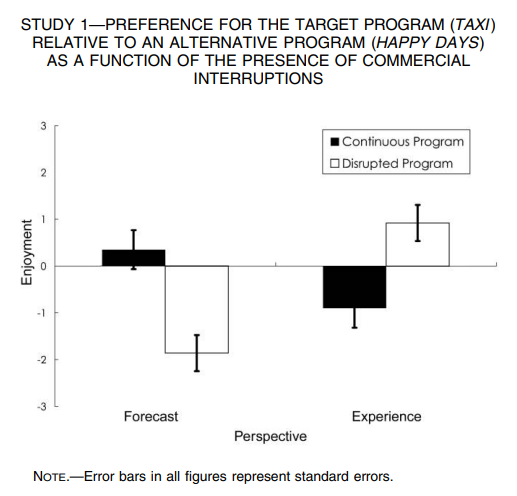And Now for This Commercial Interruption

by Nick Ellinger, Chief Brand Officer
Some things are inevitable. Death. Taxes. Hating commercials and ad breaks.
But do we really hate commercials, or do we just say (and think) we do?
Researchers analyzed this across six studies. They found we prefer to watch interrupted media. We prefer watching TV with commercials (graph from the study below). We prefer when commercials are in the middle of a program, not at the beginning or end. We’d pay more for a DVD if the movie is interrupted by ads. We even prefer that commercials interrupt our programs even if they are bad commercials.

This has important implications for we marketers.
Our brains like interruptions
Our brains get used to our situations. Work in construction; you’ll eventually not notice the noise. Work at a forge; you’ll eventually not notice the heat. Get excited by a movie; you’ll eventually not notice the excitement.
A commercial breaks up that emotional state, so when you return, you’re ready to experience your program anew. It’s also why shows have evolved from one main plot to an A, B, and C plot at the same time. Think of the end of any Star Wars movie that cuts among three things (usually space battle, ground battle, and lightsaber battle). The variety ensures that we can have different emotional arcs.
So too is it for your storytelling. Take a direct mail piece. Your main narrative will be broken up by asks and tales about how your organization helps. You’ll even vary the language of your sentences so that the brain doesn’t get used to the same style of narrative.
Even sentence fragments like this one.
Our brains like surprises
Most of what determines whether we are satisfied with an experience isn’t how good the experience was objectively. It’s how it performed against our expectations. Think of a recent fast food experience versus a fine dining experience that disappointed you. The fine dining experience was probably still better in a blind taste test, but since you paid and expected more, you were disappointed.
Thankfully or un-, it’s relatively easy to exceed donor expectations versus the average nonprofit. A call, a handwritten note, a remembered birthday, a customization in message that shows that you know the donor – these all can make someone’s day and increase the satisfaction and retention of the donor.
People don’t often know what they want
Note in these studies that, even though people liked commercial interruptions better, they said they wanted no commercial interruptions. We humans lack metacognition, a fancy-pants way of saying we don’t know why we think what we think.
So often the worst way to find out why someone believes what they do is to ask them. You may be thinking, “Wait a second! Doesn’t Moore have an entire Lab dedicated to learning what donors think?”
Yes, but:
- The Neuro-Fundraising Lab uses neuromarketing studies to determine what we’re thinking that we can’t articulate. If your pupils dilate, your pulse quickens, and your skin increases its electrical conductivity (yes, really), your body is saying you like what you are looking at, regardless of what your mouth says.
- When we use traditional surveying, we ask questions that people can answer. If you ask, “Why do you think that?”, you are asking for bad data because the person likely doesn’t know that themselves. However, you can ask about general satisfaction and satisfaction with the factors of an experience and create a model that uses the factors to predict satisfaction.
That’s why solid research is so vital.
We are in a noble business
Advertising gets a bad rap. People wonder who still has cable or satellite TV (when it’s more than half of the country). People wonder who is watching ads in the days of streaming (when the largest growth in streaming platforms is among ad-supported tiers and platforms).
Ads work. They not only improve our shows; they introduce great causes to great people. Can there be anything better than that?